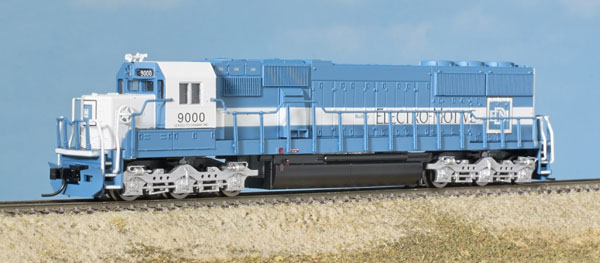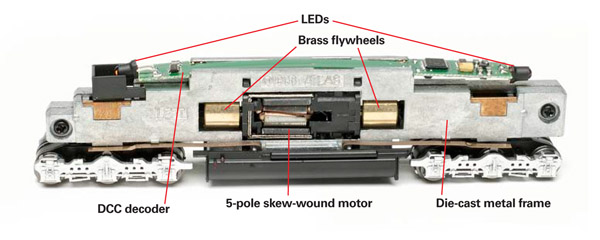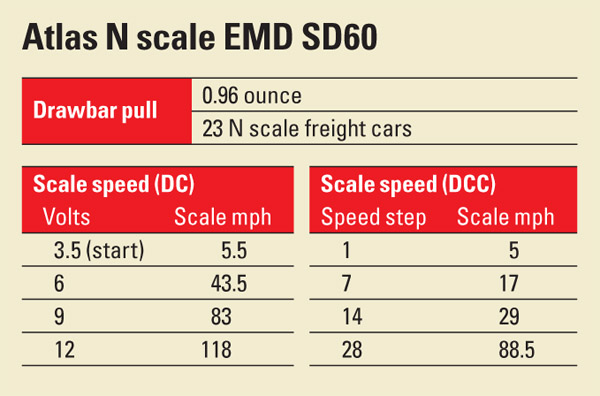History. In the early 1980s, EMD was working on a replacement for its 3,500-hp 645F prime mover. Increasing the horsepower output of that engine made the SD50 less reliable than the SD40, which also used the 645F, making the SD50 less popular than its predecessor.
Meanwhile, coal traffic out of Wyoming’s Powder River Basin was booming, and Burlington Northern RR was looking for a more powerful road locomotive. The BN wanted to pull long coal drags using fewer units. Electro-Motive Division built three demonstrator units using the new 3,800-hp 710G prime mover. The SD60 was externally almost identical to the SD50, but in addition to the new diesel engine, the SD60 included computerized controls. Numbered 8300 to 8302 and painted in BN’s tiger-stripe scheme, the three demonstrators proved capable of doing the work of five SD40s.
Between 1984 and 1991, 537 SD60s (as well as 64 wide-body Canadian variants, the SD60F) were built. However, BN – facing a cash crunch – didn’t buy any of them. Instead, the railroad arranged for Oakway Leasing, based in New Jersey, to purchase 100 units and lease them to BN on a kilowatt-hour basis. This means that BN pays for the actual work the locomotives do, rather than paying for time or miles traveled.
You can still see SD60s on the rails today, almost 30 years later, though many either have been or are in the
process of being rebuilt.
The styrene body shell is accurately detailed, with molded-in grab irons, silver-edged clear cab-window glazing, and separately applied brakewheel and horns. All major dimensions matched drawings printed in the July 1996 Diesel Era. In N scale, the sight glass window in the right side of the long hood is too small for factory-applied glazing, but a drop of Testors Clear Parts Cement & Window Maker should fix that.
The model depicts a generic SD60, with a 3-chime horn mounted at the front of the cab roof; the Oakway prototypes had the horns on top of the long hood, with a rotary beacon and an array of antennas in their place on top of the cab. The Oakway SD60s were delivered with winterization hatches on their front radiator fans, features that were removed starting in the mid-1990s. Atlas’ version comes with an optional winterization hatch that can be added by the modeler, if appropriate for the modeler’s prototype and time period.
The paint on our sample was smooth and opaque, with little to no feathering between the blue and white bands. The lettering was crisp and straight, with even the smallest printed warning labels legible under extreme magnification. After a few days of normal handling, though, paint was flaking off one of the flexible plastic handrails.
The Accumate knuckle couplers are attached to the body, not the frame, making it simple to pull off the body without removing any screws. Under the shell is a die-cast metal split frame, topped by a lighting board or Digital Command Control (DCC) decoder, depending on the version purchased. The motor and flywheels are set in an opening in the middle of the frame; the drive shafts and worm gears are entirely enclosed within the sides of the frame.
All 12 wheels pick up power and transmit it to the decoder via copper wiper strips on both sides of each truck.The blackened metal wheelsets on our sample were all in gauge, but the wheel flanges are a shade larger than called for by National Model Railroad Association standard S-4.2. The difference – .025″ rather than the recommended .022″ – shouldn’t be enough to cause problems with most commercial track, though.
Though the lights immediately came on and shone steadily, the locomotive didn’t respond until speed step 5 or 6. I programmed the decoder’s starting voltage (configuration variable 2) to 50, after which the locomotive rolled steadily at just over 5 scale mph at speed step 1. At speed step 28, the model topped out at 88.5 scale mph, a bit higher than the prototype’s top speed rating of 70 mph.
I used an MRC Tech 4 to test the model on direct current. The directional LED lights came on at just over 3 volts, and the locomotive started moving at 3.5 volts. At 12 volts, it raced along the track at 118 scale mph, speedy for an SD60.
At first, under both DCC and DC, I had trouble with the locomotive at slow speeds. Often, it wouldn’t respond to low voltages or low speed settings until I cranked up the throttle or gave the locomotive a tap or nudge. After disassembling the model, I discovered one of the trucks was binding; visual inspection showed its 1-piece sideframe/gearbox cover was snapped on at a slight angle. I removed this cover and bent a retainer clip back into place, then put it back on. I reassembled the locomotive and found its slow-speed responsiveness improved.
I also ran the locomotive on our N scale Salt Lake Route project layout. The locomotive handled the 11″-radius curves and no. 4 turnouts like a champ.
Our workbench force meter showed that at full throttle, the model mustered almost an ounce of drawbar pull, enough to move a respectable 23 standard N scale freight cars on straight, level track. Two or three consisted together, as on the prototype, should look great towing a long drag of 50 or 60 coal hoppers.
Modern marvel. SD60s have been the workhorse of American rails for nearly 30 years. Almost any modern-day N scale railroad could use a set, too, especially those that haul long unit trains. Atlas’ model sucessfully fits that niche.
Manufacturer
Atlas Model RR Co. Inc.
378 Florence Ave.
Hillside, NJ 07205
www.atlasrr.com
Era: 1984 to present
Road names: Oakway Leasing (two road numbers), Canadian Pacific, CEFX Leasing (two numbers), CSX (dark blue and yellow), Indiana Rail Road, Norfolk Southern, Panama Canal Rys. (two numbers), Soo Line, Susquehanna (two numbers), and Union Pacific. Three road numbers unless noted; also available undecorated.
Features
- Accumate knuckle couplers, at correct height
- All-wheel electrical pickup and drive
- Blackened metal wheels, in gauge
- Directional light-emitting-diode lighting
- Five-pole, skew-wound motor with dual brass flywheels
- Minimum radius 93⁄4″
- Optional user-installed plow and winterization hatch
- Split-frame mechanism
- Weight: 4.5 ounces
















